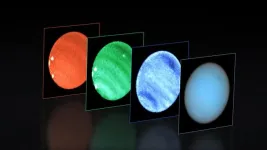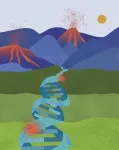(Press-News.org) Using ESO’s Very Large Telescope (VLT), astronomers have observed a large dark spot in Neptune’s atmosphere, with an unexpected smaller bright spot adjacent to it. This is the first time a dark spot on the planet has ever been observed with a telescope on Earth. These occasional features in the blue background of Neptune’s atmosphere are a mystery to astronomers, and the new results provide further clues as to their nature and origin.
Large spots are common features in the atmospheres of giant planets, the most famous being Jupiter’s Great Red Spot. On Neptune, a dark spot was first discovered by NASA’s Voyager 2 in 1989, before disappearing a few years later. “Since the first discovery of a dark spot, I’ve always wondered what these short-lived and elusive dark features are,” says Patrick Irwin, Professor at the University of Oxford in the UK and lead investigator of the study published today in Nature Astronomy.
Irwin and his team used data from ESO’s VLT to rule out the possibility that dark spots are caused by a ‘clearing’ in the clouds. The new observations indicate instead that dark spots are likely the result of air particles darkening in a layer below the main visible haze layer, as ices and hazes mix in Neptune’s atmosphere.
Coming to this conclusion was no easy feat because dark spots are not permanent features of Neptune’s atmosphere and astronomers had never before been able to study them in sufficient detail. The opportunity came after the NASA/ESA Hubble Space Telescope discovered several dark spots in Neptune's atmosphere, including one in the planet’s northern hemisphere first noticed in 2018. Irwin and his team immediately got to work studying it from the ground — with an instrument that is ideally suited to these challenging observations.
Using the VLT’s Multi Unit Spectroscopic Explorer (MUSE), the researchers were able to split reflected sunlight from Neptune and its spot into its component colours, or wavelengths, and obtain a 3D spectrum [1]. This meant they could study the spot in more detail than was possible before. “I’m absolutely thrilled to have been able to not only make the first detection of a dark spot from the ground, but also record for the very first time a reflection spectrum of such a feature,” says Irwin.
Since different wavelengths probe different depths in Neptune’s atmosphere, having a spectrum enabled astronomers to better determine the height at which the dark spot sits in the planet's atmosphere. The spectrum also provided information on the chemical composition of the different layers of the atmosphere, which gave the team clues as to why the spot appeared dark.
The observations also offered up a surprise result. “In the process we discovered a rare deep bright cloud type that had never been identified before, even from space,” says study co-author Michael Wong, a researcher at the University of California, Berkeley, USA. This rare cloud type appeared as a bright spot right beside the larger main dark spot, the VLT data showing that the new ‘deep bright cloud’ was at the same level in the atmosphere as the main dark spot. This means it is a completely new type of feature compared to the small ‘companion’ clouds of high-altitude methane ice that have been previously observed.
With the help of ESO’s VLT, it is now possible for astronomers to study features like these spots from Earth. “This is an astounding increase in humanity’s ability to observe the cosmos. At first, we could only detect these spots by sending a spacecraft there, like Voyager. Then we gained the ability to make them out remotely with Hubble. Finally, technology has advanced to enable this from the ground,” concludes Wong, before adding, jokingly: "This could put me out of work as a Hubble observer!”
Notes
[1] MUSE is a 3D spectrograph that allows astronomers to observe the entirety of an astronomical object, like Neptune, in one go. At each pixel, the instrument measures the intensity of light as a function of its colour or wavelength. The resulting data form a 3D set in which each pixel of the image has a full spectrum of light. In total, MUSE measures over 3500 colours. The instrument is designed to take advantage of adaptive optics, which corrects for the turbulence in the Earth’s atmosphere, resulting in sharper images than otherwise possible. Without this combination of features, studying a Neptune dark spot from the ground would not have been possible.
More information
This research was presented in a paper titled “Cloud structure of dark spots and storms in Neptune’s atmosphere” to appear in Nature Astronomy (doi: 10.1038/s41550-023-02047-0).
The team is composed of Patrick G. J. Irwin (University of Oxford, UK [Oxford]), Jack Dobinson (Oxford), Arjuna James (Oxford), Michael H. Wong (University of California, USA [Berkeley]), Leigh N. Fletcher (University of Leicester, UK [Leicester]), Michael T. Roman (Leicester), Nicholas A. Teanby (University of Bristol, UK), Daniel Toledo (Instituto Nacional de Técnica Aeroespacial, Spain), Glenn S. Orton (Jet Propulsion Laboratory, USA), Santiago Pérez-Hoyos (University of the Basque Country, Spain [UPV/EHU]), Agustin Sánchez Lavega (UPV/EHU), Lawrence Sromovsky (University of Wisconsin, USA), Amy Simon (Solar System Exploration Division, NASA Goddard Space Flight Center, USA), Raúl Morales-Juberias (New Mexico Institute of Technology, USA), Imke de Pater (Berkeley), and Statia L. Cook (Columbia University, USA).
The European Southern Observatory (ESO) enables scientists worldwide to discover the secrets of the Universe for the benefit of all. We design, build and operate world-class observatories on the ground — which astronomers use to tackle exciting questions and spread the fascination of astronomy — and promote international collaboration for astronomy. Established as an intergovernmental organisation in 1962, today ESO is supported by 16 Member States (Austria, Belgium, the Czech Republic, Denmark, France, Finland, Germany, Ireland, Italy, the Netherlands, Poland, Portugal, Spain, Sweden, Switzerland and the United Kingdom), along with the host state of Chile and with Australia as a Strategic Partner. ESO’s headquarters and its visitor centre and planetarium, the ESO Supernova, are located close to Munich in Germany, while the Chilean Atacama Desert, a marvellous place with unique conditions to observe the sky, hosts our telescopes. ESO operates three observing sites: La Silla, Paranal and Chajnantor. At Paranal, ESO operates the Very Large Telescope and its Very Large Telescope Interferometer, as well as survey telescopes such as VISTA. Also at Paranal ESO will host and operate the Cherenkov Telescope Array South, the world’s largest and most sensitive gamma-ray observatory. Together with international partners, ESO operates ALMA on Chajnantor, a facility that observes the skies in the millimetre and submillimetre range. At Cerro Armazones, near Paranal, we are building “the world’s biggest eye on the sky” — ESO’s Extremely Large Telescope. From our offices in Santiago, Chile we support our operations in the country and engage with Chilean partners and society.
Links
Research paper
Photos of the VLT
For journalists: subscribe to receive our releases under embargo in your language
For scientists: got a story? Pitch your research
Contacts
Patrick Irwin
Department of Physics, University of Oxford
Oxford, UK
Tel: +44 1865 272083
Email: patrick.irwin@physics.ox.ac.uk
Michael H. Wong
Center for Integrative Planetary Science, University of California at Berkeley
Berkeley, California, USA
Tel: +1 510 224 3411
Email: mikewong@astro.berkeley.edu
Bárbara Ferreira
ESO Media Manager
Garching bei München, Germany
Tel: +49 89 3200 6670
Cell: +49 151 241 664 00
Email: press@eso.org
END
Mysterious Neptune dark spot detected from Earth for the first time
2023-08-24
ELSE PRESS RELEASES FROM THIS DATE:
Loss of Antarctic sea ice causes catastrophic breeding failure for emperor penguins
2023-08-24
Emperor penguin colonies experienced unprecedented breeding failure in a region of Antarctica where there was total sea ice loss in 2022. The discovery supports predictions that over 90% of emperor penguin colonies will be quasi-extinct by the end of the century, based on current global warming trends.
In a new study published today in Communications Earth & Environment, researchers from British Antarctic Survey discussed the high probability that no chicks had survived from four of the five known emperor penguin colonies in the central and eastern Bellingshausen Sea. The scientists examined ...
Clinical outcomes and overestimation of oxygen saturation in patients hospitalized with COVID-19
2023-08-24
About The Study: Overestimation of oxygen saturation by pulse oximetry led to delayed delivery of COVID-19 therapy and higher probability of readmission regardless of race in this study of 24,000 patients. Black patients were more likely to have unrecognized need for therapy with potential implications for population-level health disparities.
Authors: Tianshi David Wu, M.D., M.H.S., of the Baylor College of Medicine in Houston, is the corresponding author.
To access the embargoed ...
Excess all-cause mortality in China after ending the zero COVID policy
2023-08-24
About The Study: In this study across all regions in mainland China, an estimated 1.87 million excess deaths occurred among individuals 30 years and older during the first two months after the end of China’s zero COVID policy, a proactive strategy that deploys mass testing and strict quarantine measures to stamp out any outbreak before it can spread.
Authors: Hong Xiao, Ph.D., and Joseph M. Unger, Ph.D., M.S., of the Fred Hutchinson Cancer Research Center in Seattle, are the corresponding authors.
To access the embargoed study: Visit our For The Media website at this link https://media.jamanetwork.com/
(doi:10.1001/jamanetworkopen.2023.30877)
Editor’s ...
Assessment of AI chatbot responses to top searched queries about cancer
2023-08-24
About The Study: The findings of this study suggest that artificial intelligence (AI) chatbots generally produce accurate information for the top cancer-related search queries, but the responses are not readily actionable and are written at a college reading level. These limitations suggest that AI chatbots should be used supplementarily and not as a primary source for medical information.
Authors: Abdo E. Kabarriti, M.D., of the State University of New York Downstate Health Sciences University ...
Combining immunotherapy with KRAS inhibitor eliminates advanced KRAS-mutant pancreatic cancer in preclinical models
2023-08-24
HOUSTON ― Researchers at The University of Texas MD Anderson Cancer Center have uncovered a functional role for KRAS mutations in pancreatic cancer and rapidly translated these findings into a novel therapeutic approach combining a KRAS G12D inhibitor with immune checkpoint inhibitors for early- and late-stage KRAS G12D-mutant pancreatic cancer. The combination therapy led to durable tumor elimination and significantly improved survival outcomes in preclinical models, leading to the launch of a Phase I clinical trial.
Two studies, published today in Developmental Cell and Cancer Cell, describe why KRAS-targeted monotherapy likely is not enough ...
Breakthrough in β-lactam synthesis using nickel catalysts
2023-08-24
Led by Director CHANG Sukbok, scientists from the Center for Catalytic Hydrocarbon Functionalizations within the Institute for Basic Science (IBS) have made a significant advancement in the synthesis of β-lactam scaffolds, which are structural components frequently found in essential antibiotics such as penicillins and carbapenems. This breakthrough overcomes challenges in β-lactam synthesis to promise streamlined pathways for drug development.
The core chemical structure that makes up penicillins is a four-membered cyclic amide scaffold called chiral ...
Lignocellulose bio-refinery developed for value-added chemical overproduction in yeast
2023-08-24
Lignocellulosic biomass is a renewable feedstock for 2nd-generation biomanufacturing. In particular, efficient co-fermentation of mixed glucose and xylose in lignocellulosic hydrolysates is a key issue in reducing product costs.
However, co-utilization of xylose and glucose in microbes is challenging due to limited xylose assimilation and the glucose repression effect.
Recently, a research group led by Prof. ZHOU Yongjin from the Dalian Institute of Chemical Physics (DICP) of the Chinese Academy ...
ChatGPT shows limited ability to recommend guidelines-based cancer treatments
2023-08-24
Correct and incorrect recommendations inter-mingled in one-third of the chatbot’s responses, making errors more difficult to detect
For many patients, the internet serves as a powerful tool for self-education on medical topics. With ChatGPT now at patients’ fingertips, researchers from Brigham and Women’s Hospital, a founding member of the Mass General Brigham healthcare system, assessed how consistently the artificial intelligence chatbot provides recommendations for cancer treatment that align with National Comprehensive Cancer Network ...
Topography of the genome influences where cancer mutations thrive, study shows
2023-08-24
Researchers at the University of California San Diego have uncovered a connection between the topography of the human genome and the presence of mutations in human cancer. They found that certain regions of the genome, which exhibit unique features, act as hotspots for the accumulation of mutations.
The findings, published recently in Cell Reports, shed light on how the 3D architecture of the human genome may play a role in the development of various forms of cancer.
The human genome is often visualized as the iconic DNA double helix, composed of long sequences of the letters A, C, G and T. “However, the genome ...
Pioneering treatment highly effective for rare kidney disease
2023-08-24
A pioneering drug for a rare kidney disease prevents organ failure and significantly improves the outcome for patients, new research has confirmed.
Atypical Haemolytic Uraemic Syndrome (aHUS) is a genetic life-threatening condition caused by a defect in the immune system which leads to kidney failure.
Newcastle University, UK, carried out clinical trials into the drug, eculizumab, which eventually led to the NHS approving the treatment for use in patients from 2015.
Now, a study by Newcastle experts, published in Blood, ...






